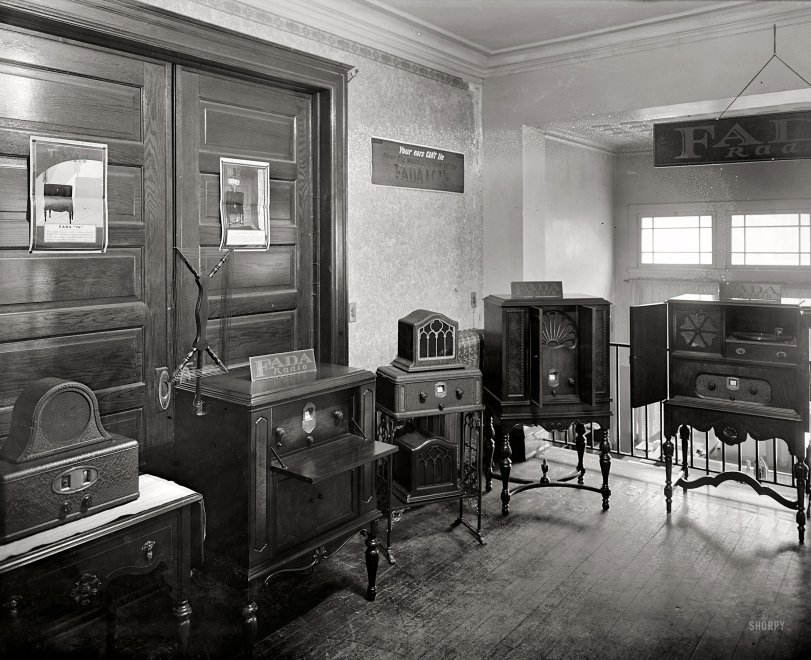


Framed or unframed, desk size to sofa size, printed by us in Arizona and Alabama since 2007. Explore now.
Shorpy is funded by you. Patreon contributors get an ad-free experience.
Learn more.

- Alas, hidden from view
- Exclusive pump
- Details, Details
- What's that building to the left of the tower?
- Coal Barges
- Bromo-Seltzer
- Inner harbor
- The Basin
- What a headache!
- Giant stepladder?
- Baldwin 62303
- Baldwin VO-1000
- Cold
- No expense spared
- Tough Guys
- Lost in Toyland
- And without gloves
- If I were a blindfolded time traveler
- Smoke Consumer Also Cooks
- Oh that stove!
- Possibly still there?
- What?!?
- $100 Reward
- Freeze Frame
- Texas Flyer wanted
- Just a Year Too Soon
- WWII -- Replacing men with women at the railroad crossing.
- Yes, Icing
- You kids drive me nuts!
- NOT An Easy Job
Print Emporium
Hello Fada: 1929

Washington, D.C., circa 1929. "Loomis Radio School." A display of Fada radio sets. National Photo Company Collection glass negative. View full size.
Reply to Dbell
Too late. It was 15 yrs. ago and we ended up donating them to a charity's thrift store (who really did not seem too excited to accept them) along with lots of other items I thought would have been snapped up by collectors. It was before E-Bay.
1929 Radio Cabinetry
Like most other radio companies of the day, FADA used beautiful mahogany/walnut veneers & hardwoods to make their cases. Seeing this display makes me recall the scent of the brown paste wax we used on our pre WW2 radio to keep it looking beautiful well into the 1950s. After we got our first TV, the big console radio gradually received less attention.
Those radios were very expensive
Second from left with an antenna mounted on the side is the Fada model 70 that was available in 1928 and 1929. According to the Fada dealer price list from December 1, 1928, the Z version of that model cost the dealer $204 and carried a recommended retail price of $340. Ford's least expensive model A roadster cost only $385 at the time.
Re: Unwanted consoles
I'll gladly pay for shipping!!!
Fada Flash-O-Graph
The "flashograph" on the models shown here was a strictly mechanical arrangement of notches in the tuning dial and a switch actuated by the notches which lit a pilot lamp when the corresponding station was tuned in. It was more of a novelty than a true tuning indicator, as it relied on accurate dial calibration which would slip over time as components aged.
Later on Fada added a true tuning indicator which was activated by the automatic volume control signal of the radio circuit that would both tell the operator when the station was tuned in for maximum signal strength, and the call (name) of the station being tuned by the mechanical dial indicator illuminated by the pilot lamp.
The dials had to be customized for the area where the radio was to be used.
Here's a link to an article that outlines early tuning indicators. http://ow.ly/dRRBA
Unwanted Consoles
When my mom passed and we were emptying our her Ct. home of 55 years, we found three beautiful condition full size wooden with bakelite knobs, console radios from the 30's & 40's in her attic. One was a Crosley, one a G.E., can't remember the third brand, but we put them in the estate sale for $35 each (2 still worked). After four days of crowds buying her stuff, we still had not had a single offer on any of the radios, so we put "free" on them. Still no takers. Seems nobody has the space to store them and prefer their pocket size Ipods. I suppose it's like strapping a full size grandfather clock on your back instead of wearing a wrist watch.
Re: Top of the range Ma
And those prices did not include the tubes!
Famous case
Here's a bit of trivia about Fada: the 1927 Supreme Court of Canada decision in Fada Radio v Canadian General Electric is frequently cited in Canadian patent law. Fada challenged the validity of CGE's 1920 Canadian patent 196390 on Irving Langmuir's "current amplifying system" - and lost. (The court ruled a false statement to the examiner does not invalidate a patent if there is no fraud.) The patent, as I understand it, was for a 2-stage radio with an RF amplifier/detector first stage and an audio amplifier second stage.
Top of the range Ma
These must have been the real top of the range radios back then, some models cost $228 which is equal to about $3200 today. Advert from Spokane Daily Chronicle 1930 here. No doubt a Shorpyite will explain just what a flashograph is.
FA.D'A.
FADA was an acronym for Frank A. D'Andrea, the radio company's founder and CEO.
























On Shorpy:
Today’s Top 5